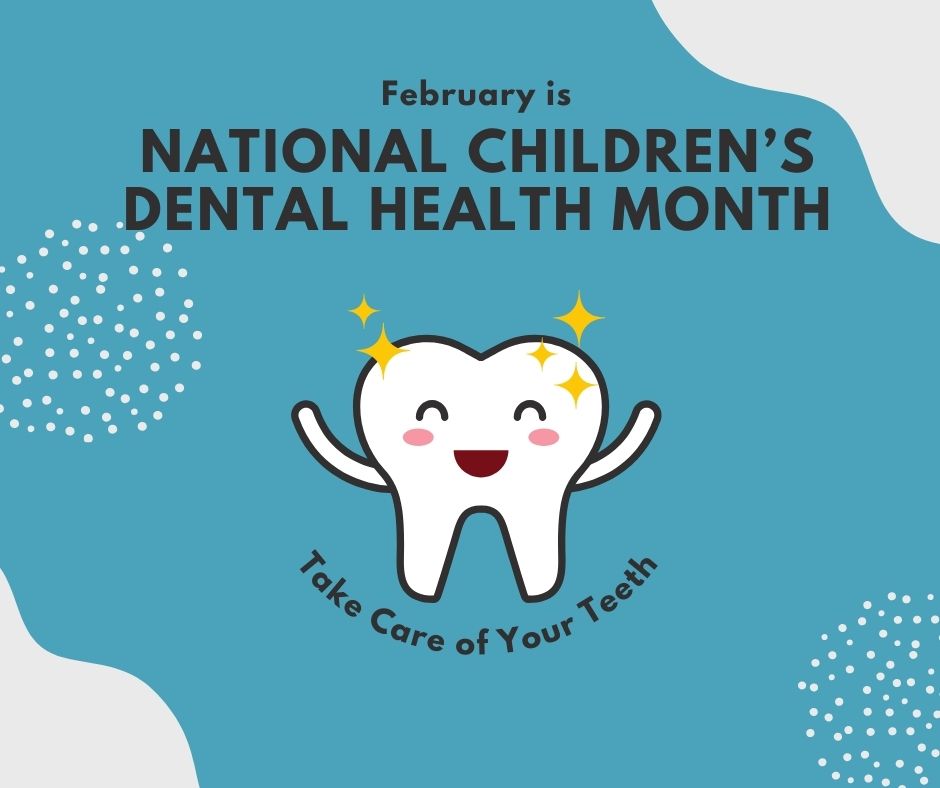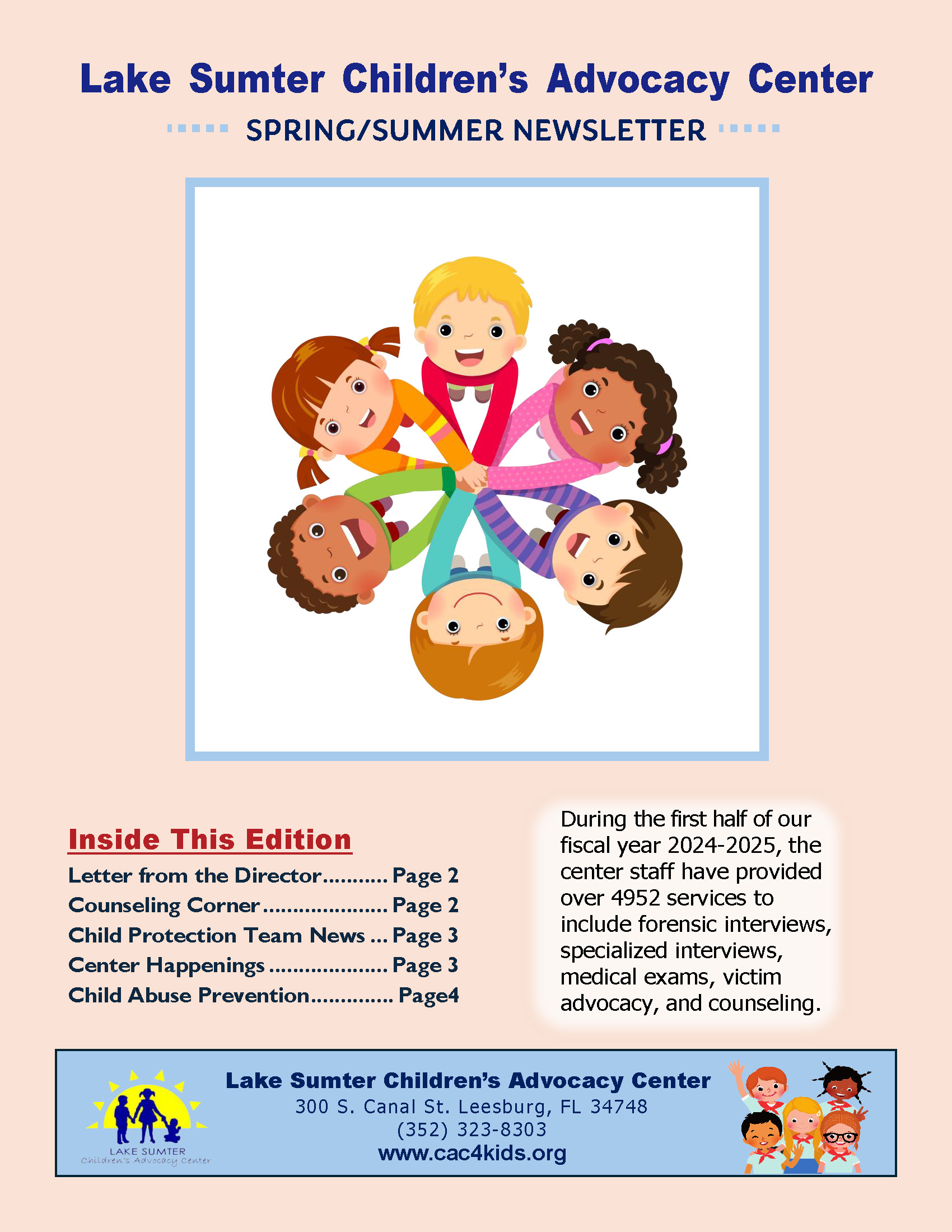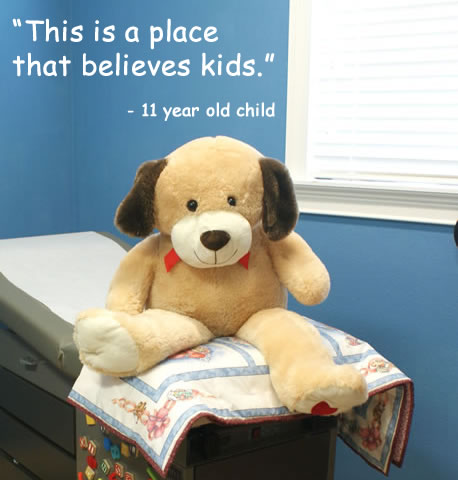INFORMATION & RESOURCES
Despite our best efforts, child abuse continues to occur in Lake & Sumter Counties. The best way to prevent further child abuse is by knowing the signs of child abuse and what programs are available through your CAC. You can also help by sharing this information with others and raising awareness in your community about child abuse.
"Safer, Smarter Kids" YouTube Channel for K-5th Graders
Check out these EMMY Award-winning videos for K - 5 that teach personal safety from a place of fun, and not fear with Lauren Book, Founder and CEO of Lauren’s Kids. This YouTube channel is perfect for parents, caregivers, educators and children looking for resources to teach and learn safety.
Children's Dental Health Awareness Month
February is National Children’s Dental Health Month. Cavities are the most common chronic disease of childhood and are 100% preventable.
You can protect and maintain your child’s teeth by following these simple steps below from the CDC:
P-E-A-R-L-S of Wisdom
- Protect tiny teeth by caring for your mouth when you’re pregnant.
- Ensure to wipe your baby’s gums after each meal.
- Avoid putting babies to bed with a bottle.
- Remember to brush your child’s teeth twice daily with fluoride toothpaste, starting at the age of 2.
- Limit drinks and food with added sugars for children.
- Schedule your child’s first dental visit by their first birthday or after their first tooth appears. Their tiny teeth matter!
Questions to Consider:
Are you watching what your child eats and drinks?
Does your community water contain flouride?
Have you asked your child’s dentist about sealants?
Get more information and resources from the Center for Disease Control

Teen Dating Violence Awareness Month
February is Teen Dating Violence Awareness Month (TDVAM). According to LoveIsRespect.org, relationships exist on a spectrum, and it can sometimes be hard to tell when a behavior goes from healthy to unhealthy (or even abusive).
Typical warning signs of abuse from your partner include:
- Checking your phone, email, or social media accounts without your permission.
- Putting you down frequently, especially in front of others.
- Isolating you from friends or family (physically, financially, or emotionally).
- Extreme jealousy or insecurity.
- Explosive outbursts, temper, or mood swings.
- Any form of physical harm.
- Possessiveness or controlling behavior.
- Pressuring you or forcing you to have sex.
Learn more at LoveIsRespect.org
Text “LOVEIS” to 22522 to speak to an advocate. This organization is a project of the National Domestic Violence Hotline and offers advocates who listen without judgment and can help identify possible signs of abuse in your relationship.


Resources for Families Dealing with Child Abuse
At the Children's Advocacy Center, we understand the many questions and concerns that arise from child abuse. Our staff have compiled a list of books that may provide you with additional guidance during your healing journey. It's important to note that these books are supplementary and should not be used as a replacement for therapy.
We have recommendations for Parents, Teens, Children, and Adult Survivors, as well as additional resources.

Halloween Safety Tips
Ensure a safe and happy Halloween, with these safety tips from the National Safety Council:
Check Your costume!
- Make sure all materials are fire-resistant
- Use glow sticks or reflective tape
- Choose nontoxic Halloween makeup, rather than masks
- Test makeup on a small area to check for irritation
- Carefully remove all makeup when done
Trick-or-Treat Safely!
- Take a responsible and trusted adult or chaperone
- Agree on a time to return home
- Remind kids to never enter a stranger's home or car
- Stay with your group and stick to familiar and well-lit areas
- Discuss any food allergies and make a plan to eat treats only after returning home
Drive Carefully!
- Always watch for children
- Keep an eye out for children in dark clothing
- Double-check blindspots
- Keep inexperienced drivers away from the wheel

CHILD ABUSE PREVENTION MONTH
As we all know, April is Child Abuse Prevention Month. Each year we re-double our efforts to keep children safe by raising awareness concerning the devastating impact of abuse to the minds, bodies and spirits of victimized youth. Such efforts remind us of the constant vigilance we must exercise to protect our children from those who would rob them of their child- hoods and strip them of their innocence. While we may never altogether eradicate child abuse and the conditions that precipitate it, it is always worthwhile to issue routine cautionary reminders to parents and caregivers in their earnest quest to keep their children safe. Accordingly, the U.S. Department of Health & Human Services offers the following instructive pointers to combat abuse:
- Take an active role in your children’s lives. Learn about their activities and people with whom they are involved. Stay alert for possible problems.
- Watch for “grooming” behaviors in adults who spend time with your child. Warning signs may include frequently finding ways to be alone with your child, ignoring your child’s need for privacy (e.g., in the bathroom) or giving gifts or money for no particular occasion.
- Ensure that organizations, groups and teams that your children are involved with minimize one-on-one time between children and adults. Ask how staff and volunteers are screened and supervised.
- Make sure your children know that they can talk to you about anything that bothers or confuses them.
- Teach children accurate names of private body parts and the difference between touches that are “OK” and “not OK.”
- Empower children to make decisions about their bodies by allowing them age-appropriate privacy and encouraging them to say “no” when they do not want to touch or be touched by others, even in non-sexual ways.
- Teach children to take care of their own bodies (e.g., bathing or using the bathroom) so they do not have to rely on adults or older children for help.
- Educate children about the difference between good secrets (such as birthday surprises) and bad secrets (those that make the child feel unsafe or uncomfortable).
- If your child tells you that he or she has been abused, stay calm, listen carefully and never blame the child. Thank your child for telling you. Report the abuse right away.
- Monitor children’s use of technology, including cell phones, social networking sites and messaging. Review contact lists regularly and ask about any people you don’t recognize.
- Trust your instincts. If you feel uneasy about leaving your child with someone, don’t do it. If you are concerned about possible sexual abuse, ask questions.
CAC NEWSLETTER
Our newsletter contains a wealth of information regarding our Center and the services we offer, as well as information and resources regarding child abuse and neglect.
Spring-Summer 2025 Newsletter - click to download
- Letter from the Director
- Counseling Corner
- Child Protection Team News
- Center Happenings
- Child Abuse Prevention
Fall-Winter 2024 Newsletter - click to download
- Counseling Corner
- Family Advocate Corner
- Child Protection Team News
- Center Happenings
Fall-Winter 2023 Newsletter - click to download
- Season of Gratitude
- Department Updates
- Center Happenings
- Bids for Kids 2024 - Save the Date
January 2023 Newsletter - click to download
- The Toymakers: Crafting Joy
- From the Editor - New Year 2023: Keeping it Positive
- MDCT Giving Week: "And the Winners Are..."
- Holiday Happenings at the Center
October 2022 Newsletter - click to download
- From the Editor: "An American Tragedy"
- Changing of the Guard
- On the Road to Sumter
- MDCT Giving Week 2022
- "Anonymous: A Poem"
July 2022 Newsletter - click to download
- Editorial: "Peace, Lillie"
- Getting to Know Holly B., ARNP
April 2022 Newsletter - click to download
- NCA Site Review: A Time to Shine
- Editorial: The Importance of Being Earnest
- Bids 4 Kids Alive and Well
- Meet Erlande Alexandre, Counselor
- "Beware of Slime"
- Bikers "C.A.R.E." Pinwheel Run
January 2022 Newsletter - click to download
- Meet Executive Director Brenda Crellen
- On Resolutions and Friendships
- One Door Closes, Another Opens
- Santa's Curbside Christmas Pictorial
October 2021 Newsletter - click to download
- Pulse to Pubescence: A Counselor's Journey
- From the Editor: What We Leave Behind
- The VOCA Fix: In the Nick of Time
- The Star Thrower: A Story of Faith and Hope
July 2021 Newsletter - click to download
- Family Advocacy: Straight from the Heart
- From the Editor: In Search of the "Inner Child"
- CPT Newcomer Introductions
- KCI: A Most Valued Community Partner
April 2021 Newsletter - click to download
- Forensic Interviewing: The Artful Search for Truth
- From the Editor: A Poem “On Becoming”
- Reminders on Keeping Kids Safe
January 2021 Newsletter - click to download
- Human Trafficking: Up Close and (Far Too) Personal
- From the Editor: A Story About “Baby Steps”
- A Poem: “Santa’s Curbside Christmas”
October 2020 Newsletter - click to download
- Counseling Corner Supervisor Q & A
- From the Editor’s Desk: Vote for Children
- Medical Musings On Kid Care
- Bids4Kids and COVID: What’s Next
- Strategic Planning On Vicarious Trauma
July 2020 Newsletter - click to download
- The CAC Model: Integrated Child Abuse Services
- COVID 19 & Telehealth
- A CPT Success Story
SEVEN FUN FACTS ABOUT CHILD DEVELOPMENT
-
At 2 years of age, a child has more than 100 trillion
new brain connections, or synapses. However,
when a child finally becomes an adult, more than
50% of these acquired synapses disappear.
Where,
oh where, did my synapses go??
-
If a baby’s body was able to grow at the same rate
as its brain, the average child would weigh as
much as 170 pounds at 1 month old.
OMG!
-
By the age of 6, the average child has a vocabulary
of about 13,000 words. An average adult has a
vocabulary of about 60,000 words.
Catching up
fast!
-
Babies and kids can laugh up to 300 times a day.
Adults typically laugh, at most, about 20 times a
day.
Time to find my “inner child”!
-
Babies and young kids both have a hard time
figuring out and separating background noises
from voices speaking. So sometimes, a toddler
isn’t ignoring being called. He/she is just dealing
with the challenge of lacking response skills.
Ok,
so how do we explain teenagers?!
-
Babies to whom their parents speak often typically
know 300 more words than their peers by the age
of 2 years old.
May the grooming for the next
spelling bee champion begin!
- A child’s brain may be at it’s full physical size by the time he/she reaches kindergarten, but brain development doesn’t slow down until his/her twenties. (There’s my explanation for teenagers!)


SIGNS OF CHILD ABUSE
The following is a brief list of the signs of child abuse. Keep in mind that these signs can be subtle.
- Unexplained injuries
- Changes in behavior
- Returning to earlier behaviors
- Fear of going home
- Changes in eating
- Changes in sleeping
- Changes in school performance and attendance
- Lack of personal care or hygiene
- Risk-taking behaviors
- Inappropriate sexual behaviors
If you have questions or concerns about a child in your life, please don't hesistate to contact the CAC at (352)323-8303 or info@cac4kids.org. One of our caring and knowledgeable staff can listen to your concerns and offer guidance on next steps.



